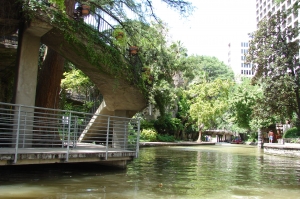
Innovative cities and economic development organizations are collaborating to stimulate growth, improve public health and enhance tax revenue. And, they are doing it at very little cost. Sounds almost too good to be true…but it’s all happening when urban parks and green spaces are developed and maintained.
Studies show that urban parks and green spaces improve public health by encouraging physical activity and increasing the amount of time citizens spend outdoors. Parks also foster community involvement, promote arts and cultural programs and reduce crime. But, perhaps the most immediately noticeable benefit is the positive economic impact that green spaces provide.

San Antonio River Walk – Photo by David R. Tribble
Property values go up significantly when urban parks and green spaces are developed. In Boulder, Colo., a recent study pointed out that property values decrease by more than $4 for each foot they are away from a greenbelt. In a similar study completed in New York City, an analysis of neighborhoods with green spaces found that parks have an extremely positive effect on property values, especially in disadvantaged neighborhoods. The increased property values result in more municipal revenues that cities can use for economic development in other areas.
Green spaces and parks in urban areas also attract new residents, office relocations and other types of entertainment venues. They also attract one particular group of desirable urban residents – retirees. According to the U.S. Census Bureau, approximately one in every four Americans will be 65 years of age or older by the year 2050. They have regular income checks each month and, when given a choice, they prefer to live where there is scenic beauty and outdoor venues. A recent study shows that when 100 retired households move to a community, the economic impact is similar to that of a new business spending $4 million annually in the community.
Another demographic group that has consistently shown an attraction for green spaces are so-called “knowledge workers” – people whose work focuses more on selling specified knowledge or skills as opposed to physical labor. Examples include software engineers, academics and computer programmers. These individuals prefer to live in places with a diverse range of outdoor recreational activities including walking trails, cycling routes and areas for outdoor sports and activities. This young and affluent demographic is a key target for cities wanting to capitalize on the economic impact that comes along with new residents.
Along with encouraging economic growth, parks and green spaces help manage storm water runoff, reduce air pollution and protect water quality. A Massachusetts study reports that every $1 invested in conserving or expanding green spaces produces a $4 return for natural goods and services.
The River Walk in San Antonio, Texas, a beautiful strip of water and greenery in downtown, is lined on both sides with a variety of shops and restaurants. The primary appeal of the area, for both tourists and locals, is the greenery and natural scenery. The annual economic impact of the River Walk is $3.1 billion.
New York City’s Central Park Conservancy released a study on the park’s economic impact and reported that the park was directly responsible for more than $1 billion in revenue every single year. In Chicago, the combined revenue generated by all city parks tops $600 million annually. Seattle’s network of urban parks provides the city with annual revenues of $19.2 million and a municipal cost savings of $12.4 million.
There are so many reasons to encourage the development of urban parks and green spaces in cities that it is easy to overlook a very basic one. People simply need green spaces that encourage an escape, however brief, from the hustle and stress of everyday life.
